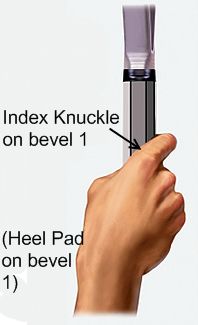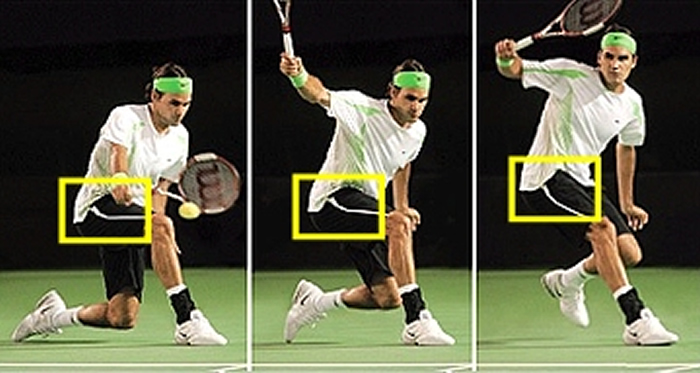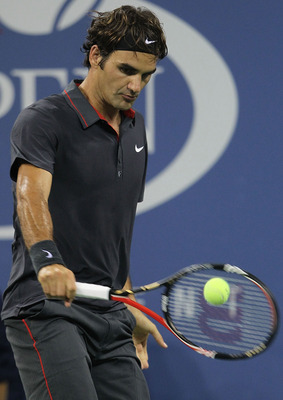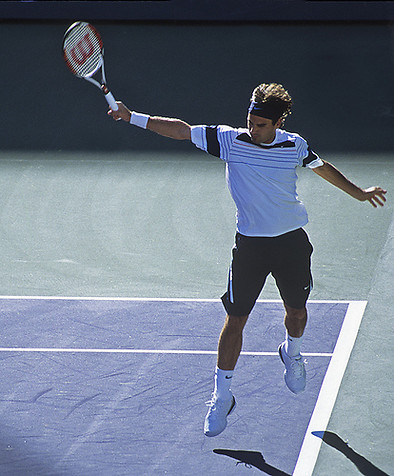Players around the world admire Federer’s backhand as one of the most elegant in the game today.
While Roger Federer’s forehand gets a lot of press, especially the inside-out version, his elegant backhand can sometimes get overlooked in the hubbub over his mysterious forehand grip and stroke. That’s a shame, because his backhand might be one of the most beautiful strokes in the game, even if it has let him down from time to time in huge matches.
Basics of Roger Federer’s Backhand Grip
The gorgeous Roger Federer backhand begins with the Federer backhand grip, which some analysts have called a modified Eastern grip. In most photos of the Federer backhand grip, it looks as if his index finger knuckle is aligned at about 1 o’clock on the racquet handle if it were held out straight from his body. This special grip gives his racquet the angle it needs to swipe through the stroke and whip enough topspin onto the ball so that it drops just inside the opposite baseline.

Now that the Federer backhand grip has been deciphered, let’s look more closely at his complete stroke, one of the last one-handed backhands among the top players in the world:
Initial Racket Preparation of the Roger Federer Backhand
In his racquet preparation for the backhand, Federer holds it far above the point of contact. This is an important point for most amateur players; even if the racquet is held back before hitting the backhand, is it high or low in the first part of the preparation?
In most players’ cases, it is low, robbing the backhand of much of its potential power. If it’s high, the racquet can make a complete loop through to the ball, adding much zing to the pace and telling your opponent that picking on your backhand is not a wise idea.
Beyond the Federer Backhand Grip: Getting the Proper Body Turn and Coil


As part of his preparation Federer also holds the racquet’s throat with his left hand, probably a reminder to hold the racquet even further back than is customary. You, too, can use the other hand if you hit a one-handed backhand, to pull the racquet further back than you might be naturally inclined to. It also will help you turn your back properly, as it does Federer.
As his back is turned, he peers at the ball over his shoulder, loading his core muscles for a quick but powerful rotation that will bring his upper body to a square position when contact is made. Preparation is about more than racquet position; your back must also be turned to get your core involved in the stroke, especially for devotees of the one-handed backhand. That’s also what makes this stroke a thing of beauty when properly struck.
Racket backswing Leads Directly to the Downswing in the Federer Backhand
As Federer continues his loop to the ball, he drops the racquet head below it to prepare for the contact that will soon arrive. In comparing the initial preparation to the split second before Federer hits the ball, one body part that has not changed at all is his head. It is still and his eyes are following the ball into the racquet. Your eyes might be the most important part of your body for any ground stroke.


This is especially important to remember if a match is not going your way. Take a deep breath and simply concentrate on hitting the ball solidly. A large part of that will involve you watching the ball all the way to the racquet head. Try it next time that you hit, and you’ll be using your sweet spot more than you are accustomed to.
Contact Point Using Roger Federer’s Backhand Grip


As Federer meets the ball, his racquet is usually parallel to the ground. A lot depends on where the shot has been hit and whether or not he has to reach to get it. This will be true for you as well. All things being equal, and assuming that you have time to properly set up before launching your backhand, the racquet should be approximately parallel to the ground as you meet the ball. The stance at this point is more closed than on the forehand.
Because the backhand shot will have less power due to the physics of the shot and your body’s movement, a more closed stance is required. This will guarantee greater rotation as you put the full force of your body into the ball. Federer has also transferred his weight from back to front, and seeing his back foot perched on just one toe proves this weight shift.
In other photos, Federer demonstrates an incredibly flexed calf on his front leg proves that he is using it to crush the ball. What do your feet look like at this point? Flat to the ground?
Then you are probably not transferring your weight as you should. You will need all of that momentum to hit the one-handed backhand with enough force to turn it into an asset for your game.
The Roger Federer Backhand Grip: A Natural Low to High Follow Through


As Federer begins his follow-through, his shoulders are perfectly parallel to the baseline, presenting a fortified wall to the ball. In many action shots, Federer’s back foot is entirely off the ground at this point. All of his weight has been moved up front to power through the ball. If you ever hope to hit your one-handed backhand with suitable pace, you will need to present a similar wall to strike the ball.
Two other constants strike the viewer in looking at Federer’s technique: the Federer backhand grip remains as the knuckle has stayed at 1 o’clock, and his eyes are still on his racquet head, still peering at the point in space where strings met ball.
Now to the most photogenic part of the properly executed one-handed backhand: the exquisite follow-through, as best exemplified by Federer and Justine Henin on the women’s side. Federer has brought his racquet far above his shoulder as he has struck the ball with maximum topspin, going from below the waist to above the shoulder.
To complete the beauty of this typical photo, Federer has extended his left arm out and behind him as a counterbalance. In this moment, Federer looks more like a ballet dancer than a tennis player. He would look equally comfortable in Swan Lake as on the hallowed grounds of Wimbledon.
Comparing Your Own One Handed Backhand Shot to Roger Federer
Now, onto your backhand, especially those of you who favor the one-handed variety. Where is your racquet at the end of the shot? Just a few inches past contact? Where is your free arm and hand? Tucked into your body? Are you stiff and under-confident or free and graceful? What you look like on that follow-through will tell everyone all they need to know about your one-handed backhand, yet this is often the most neglected component of the shot. It shouldn’t be. Practice your follow-through until you look something like Federer, who appears ready to take winged flight over the entire tennis complex after hitting his glorious backhand.
Federer’s Slice Backhand Technique
The technique used for a slice backhand will differ a bit from the steps described above, but the main differences will be the weight transfer from back to front (more limited) and the rotation of the core (also diminished). A slice backhand hit with too much whip of the body will either soar into the air or fall short of the net. The slice will be hit with a more open stance, but the follow-through should not be neglected.


The height of the ball will often determine whether or not you hit a slice; high balls will be almost impossible to put any topspin on, thus necessitating a slice option. That’s not all bad. Sliced backhands will stay low and force your opponent to get low or miss the shot.
Federer Backhand Grip – One of the Prime Examples to Model in Today’s Game
The Federer backhand, one of the true objects of beauty in the men’s game, begins with his modified Eastern grip and continues with fundamentals that you, too, can adopt: head still, eye on the ball, closed stance, coiled body, low to high swing, dynamic follow-through. All of these will change a bit if you hit the backhand with two hands, but if you want to hit a one-hander, Federer is an excellent example to follow.
Learn to Hit a Forehand Like Roger Federer
If you want to jumpstart your forehand and play like the PROS, check out my 70+ page Tennis Ebook that will immediately show you how you can take your forehand to the next level.
The Modern Forehand Domination Ebook is guaranteed to improve your tennis technique, and increase power, topspin and accuracy of your tennis forehand!
Modern Tennis Forehand Ebook
Learn How to Hit a Forehand Like Federer, Nadal and Djokovic

